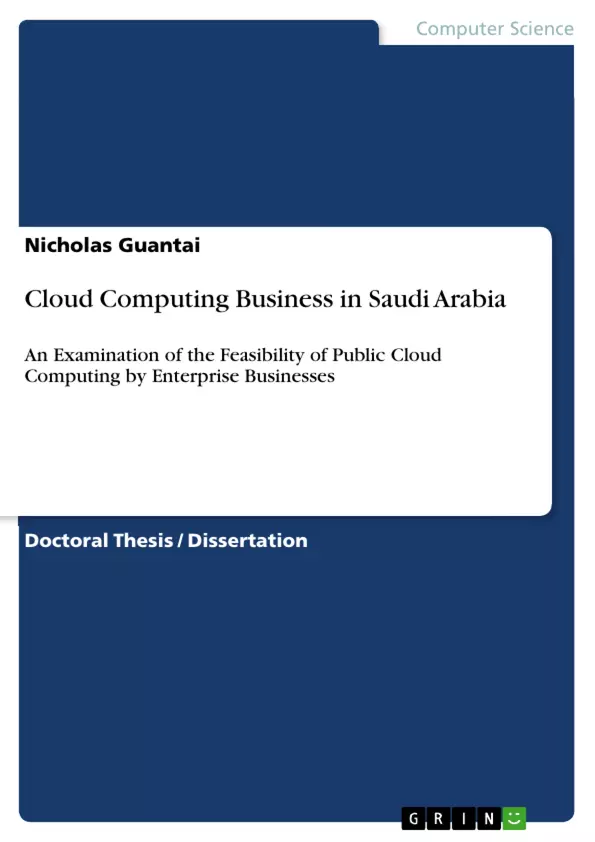Cloud computing has 3 primary service models including SaaS, IaaS and PaaS, which are classified depending on the level for which a service user interacts with the service provider’s systems in accessing memory, processing power and storage. Deployment models of cloud computing include hybrid, community, public and private clouds depending on the approach to hosting and the number of clients sharing a resource. Due to the prohibitive nature of private cloud computing and requirement for specialized systems in community clouds, the most suitable approach to cloud computing for small and medium enterprises is public cloud computing. In this regard, this study was aimed at determining the extent to which implementation of public cloud computing by enterprise companies is feasible. Due to the cultural and the absence of law in Saudi Arabia ensuring the protection of data in the cloud, challenges in implementing cloud computing in the country are related to adherence to the data governance structure. For instance, privacy and security are important for enterprise companies since the local culture values the safeguarding of family and individual information. In addition, information transferred through the cloud system must adhere to the conservative philosophy and data privacy, which limits the level of compatibility in cloud computing between Saudi Arabia and the western world. Since most service providers are based in the west, companies have to identify a service provider that tailors its products to suit the market in Saudi Arabia. Therefore, implementation of public cloud computing in Saudi Arabia is feasible as long as companies select a service provider with a positive reputation, limit posting of sensitive information to the cloud server, and implement cloud computing gradually to avert the possibility of complete failure. This study determined that SaaS cloud computing is feasible for enterprise companies in Saudi Arabia, but further study is required to examine the feasibility of IaaS and PaaS. In addition, a larger study should be done to collect quantitative data to determine the implications of cloud computing in a representative sample.
Inhaltsverzeichnis (Table of Contents)
- EXECUTIVE SUMMARY
- KEY TO ABBREVIATIONS
- CHAPTER 1: INTRODUCTION
- 1.1 STATEMENT OF THE PROBLEM
- 1.2 PURPOSE AND SIGNIFICANCE OF THE STUDY
- 1.3 RESEARCH OBJECTIVE
- 1.4 RESEARCH QUESTIONS
- 1.4.1 Main Research Question
- 1.4.2 Sub-Questions
- 1.5 SCOPE AND LIMITATIONS OF STUDY
- 1.5.1 Delimitations
- 1.5.2 Limitations
- 1.6 ROUTE MAP to the DISSERTATION
- CHAPTER 2: LITERATURE REVIEW
- 2.1 ORGANIZATION OF REVIEW
- 2.2 EMERGENCE AND ADOPTION OF CLOUD COMPUTING
- 2.3 CLOUD COMPUTING APPROACHES
- 2.4 CLOUD COMPUTING IN BUSINESS
- 2.5 CLOUD COMPUTING IN SAUDI ARABIA
- 2.6 CONCLUSION
- CHAPTER 3: DATA AND METHODS
- 3.1 MOST PROMISING METHODOLOGICAL APPROACH
- 3.2 RESEARCH DESIGN AND METHOD
- 3.3 RESEARCH PARTICIPANTS RECRUITMENT METHOD
- 3.4 RESEARCH PARTICIPANT RECRUITMENT CRITERIA
- 3.5 INTERVIEWS
- 3.6 ETHICAL ISSUES
- 3.7 LITERATURE SEARCH
- 3.8 ANALYSIS
- CHAPTER 4: ANALYSIS AND RESULTS
- 4.1 DATA ANALYSIS
- 4.2 RESULTS
- 4.2.1 Factors in Saudi environment that affect cloud computing implementation
- 4.2.2 Cloud computing services implemented by enterprise companies in Saudi Arabia
- 4.2.3 Benefits of Cloud Computing
- 4.2.4 Issues raised
- 4.2.5 Acceptability of recommendations
- CHAPTER 5: DISCUSSIONS AND CONCLUSIONS
- 5.1 FINDINGS SUMMARY
- 5.2 THEORETICAL AND PRACTICAL IMPLICATIONS
- 5.3 LIMITATIONS
- 5.4 DIRECTIONS FOR FUTURE RESEARCH
- 5.5 REFLECTIONS
- 5.6 LEARNING FROM THIS STUDY
- REFERENCES
- APPENDIX A: CONSENT FORM
- APPENDIX B: PLAIN LANGUAGE STATEMENT
- APPENDIX C: SEMI-STRUCTURED QUESTIONNAIRE
- APPENDIX D: INTERVIEW SCHEDULE
Zielsetzung und Themenschwerpunkte (Objectives and Key Themes)
This study aims to determine the feasibility of implementing public cloud computing by enterprise companies in Saudi Arabia. The research explores the cultural and legal factors that influence cloud computing adoption in the country, particularly considering the importance of data privacy and security within Saudi Arabian society. The study seeks to understand the benefits and challenges of cloud computing in this context and to develop recommendations for successful implementation.
- Cultural and legal factors affecting cloud computing adoption in Saudi Arabia
- The feasibility of public cloud computing for enterprise companies in Saudi Arabia
- Benefits and challenges of cloud computing implementation in Saudi Arabia
- Recommendations for successful implementation of cloud computing in the Saudi Arabian context
- The impact of cloud computing on data governance and security
Zusammenfassung der Kapitel (Chapter Summaries)
Chapter 1 provides an introduction to the topic of cloud computing and its relevance to businesses in the modern era. It outlines the statement of the problem, the purpose and significance of the study, and the research objectives and questions. The chapter also discusses the scope and limitations of the study, highlighting the specific context of Saudi Arabia.
Chapter 2 delves into the existing literature on cloud computing, exploring its emergence and adoption, different approaches to cloud computing, its applications in business, and its current state in Saudi Arabia.
Chapter 3 focuses on the methodology employed in the study, including the research design and methods, participant recruitment process, ethical considerations, and data analysis approach.
Chapter 4 presents the analysis and results of the study, examining factors that influence cloud computing implementation in Saudi Arabia, the cloud computing services implemented by enterprise companies, the benefits and issues raised, and the acceptability of recommendations.
Schlüsselwörter (Keywords)
The key words and concepts in this study include cloud computing, public cloud, enterprise companies, Saudi Arabia, data governance, data privacy, security, cultural context, feasibility, benefits, challenges, recommendations, and implementation.
- Quote paper
- Nicholas Guantai (Author), 2014, Cloud Computing Business in Saudi Arabia, Munich, GRIN Verlag, https://www.hausarbeiten.de/document/276573


